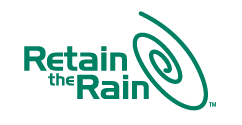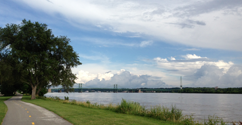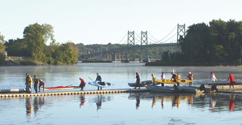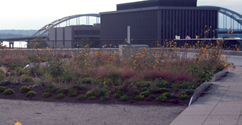Working together, we can help to lower the level of future flooding on the Mississippi River, control storm water runoff and reduce pollution of streams and rivers.
You can make a difference to reduce runoff and pollution from storm water. In urban areas, rain, melting snow or any water that doesn't soak into the ground flows into a community's storm sewers.
 The water draining into storm sewers goes directly into lakes, streams and rivers, carrying with it a variety of pollutants ranging from soil, road salt, pesticides and fertilizers, to oil, grease, leaves and litter. (Contrary to popular belief, most storm sewers don't carry water to waste water treatment plants. (Only in some older communities are storm and sanitary sewers combined.)
The water draining into storm sewers goes directly into lakes, streams and rivers, carrying with it a variety of pollutants ranging from soil, road salt, pesticides and fertilizers, to oil, grease, leaves and litter. (Contrary to popular belief, most storm sewers don't carry water to waste water treatment plants. (Only in some older communities are storm and sanitary sewers combined.)
The "Retain The Rain Virtual Kiosk" below is a fun, interactive program that calculates stormwater savings when you enter the dimensions of your roof, yard, or office project.
- Find out how you can control stormwater runoff from your home or business.
- Determine the amount of water runoff with the built in calculator.
- View area rain gardens and green roofs and find out more about your watershed.
CLICK HERE to start virtual kiosk.
Additional resources
- Controlling storm water runoff
- Rainwater harvesting
- Rain barrel conversion
- Low input lawns
- Water saving in the garden
- Parking lot development
With greater development of a watershed and more storm water runoff, stream and river levels increase faster and reach higher levels than before urbanization. In some areas, storm water runoff leads to erosion of streambanks, damages fish habitat and destroys property. Storm water runoff is difficult to control because it comes from every street, sidewalk, driveway, yard and parking lot. Consequently, managing a community's storm water runoff requires the participation of all residents. Only with all members of the community working together can storm water be managed and controlled.
Retain the Rain is an effort to raise awareness about storm water runoff and its damaging effects, and provide residents with ways to reduce storm water runoff from their property. Those property owners adjacent to wetlands, streams, lakes and rivers play a key role in the effort to manage storm water runoff.
So what should I do? The next time it rains, observe where the water runs off your property. Does the water coming out your downspouts, rooftop, sidewalk or yard soak into the ground quickly? Or, does it flow off the lawn, yard and driveway into the gutter and storm sewer drain? Are locations where runoff is occurring possible sources of contamination from oil, grease, pesticides or herbicides? Is erosion of soil apparent? Here is a list of common sources of storm water pollutants:
- Silt, sand and clay particles from erosion and washing of car/trucks on driveway or parking lots.
- Nutrients from over-use or spilled fertilizer, pet manure, grass clippings and leaves left on street.
- Metals from galvanized metal gutters or brake wear from cars/trucks.
- Pesticides from over-use, spilled or leaks.
- Hydrocarbons from oil and gas spills, burning of leaves or garbage and car/truck exhaust.
- Disease organisms from pet manure or garbage.
- Are there places where your storm water may be contaminated as it runs off your property?
Once you've assessed your property, consider ways to control/manage your storm water runoff, including:
- Planting grass or ground cover to stop erosion of soil. Native grasses with their highly developed root systems are ideal.
- If the erosion is particularly acute, landscaping alterations may be needed. For hilly lots, slopes can be terraced to slow the runoff and make maintenance easier.
- During construction of a home or business, silt fences can help slow runoff and keep sediment on-site.
- When possible, use a porous pavement surface such as interlocking cement blocks which have spaces that allow rainwater to seek into the ground. When using asphalt or concrete, keep the paved area as narrow/short as possible.
- Your roof, like your driveway, sheds water into grassy areas. Use gravel to prevent soil erosion around your house and increase the ground's capacity to absorb the water. Consider using a barrel to catch rainwater for use later to water plants/lawns.
- Consider "naturalizing" part of your yard to contain runoff.
- If you live near a creek, stream or lake, maintain a buffer strip of native grasses or flowers to slow runoff and filter pesticides/herbicides.
- Do not dump grass clippings, brush or leaves onto the stream or creek or burn yard waste near the stream bank.
To prevent pollution of streams/rivers:
- Always follow the usage rules when applying pesticides.
- Do not fertilize or apply pesticides near a creek or stream bank.
- Limit your use of de-icing salt in the winter.
- Avoid using hard surface areas, where chemicals can run off easily, when mixing/filling fertilize or pesticide applications.
- Do not dispose of oil, or excess fertilizer/pesticides in storm drains.
- If you wash your car at home, use small amounts of low-phophorus detergent and wash the suds into the grass not down the driveway.
- Maintain septic systems by having them inspected every two to three years.
Six simple things you can do to save the Mississippi River
With stormwater runoff fees and increased concern about contamination of water supplies and flooding, it makes sense to seek ways to reduce rainfall runoff from residential lots through the use of native plantings and simple retention projects.
This handbook outlines the most common retention projects to retain water on your property, allowing it to soak into the ground rather than flow into storm sewers. Most of the projects make use of native plantings because of their ability to soak up water and stabilize the soil. Native plantings are adapted well to the local environment, providing color to yards from May through October and refuge for birds, butterflies and other insects. They're also more tolerant during periods of drought.
This booklet gives you detailed plans and specifications for building the retention projects, along with estimated costs for the improvements. The projects range from simple actions, such as installing a rain barrel to capture water from your roof, to more complex jobs, such as installing a green roof. All have been or are planned for the Quad Cities area. You'll also find a Resource List of suppliers, landscapers, contractors, architects, and sources of other products and services you need in order to install the retention projects. The Shoppers Guide provides specific information about the projects featured in the photographs throughout this handbook. Working together, one home or business at a time, we can help reduce stormwater runoff in our community and improve the water quality of our streams, lakes and rivers -- most notably, the Mississippi River.
CLICK HERE, or on the image above, to download the 32-page "Six Simple Things. . ." booklet.










